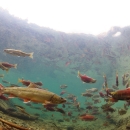In response to a general decline in abundance across their native range, Bull Trout (Salvelinus confluentus) were listed as threatened under the Endangered Species Act in 1999. Gaining a better understanding of the reproductive component of a population is important for Bull Trout recovery and persistence. Accurately monitoring the trend in abundance of spawners is essential to inform future management actions that may affect populations in the North Fork Lewis River subbasin. To estimate the abundance of the adfluvial Bull Trout spawning population, a resistance board weir and underwater video system were operated on Cougar Creek, a tributary to Yale Reservoir on the North Fork Lewis River, from July 25, 2022 through November 2, 2022. Forty observations of adults moving upstream through the weir were recorded from late-July through late October, with the peak occurring in late-September. Most of the Bull Trout observed were relatively large, migratory fish. However, smaller migratory adults and subadults were observed as well. Individual Bull Trout were documented passing the weir multiple times both upstream and downstream, which would overestimate the true population size if only upstream observations were simply enumerated. To address this concern, we used PIT tag detections in addition to a photo-identification technique to allow recognition of individuals based on natural marks, such as colors, spots, scars, and fin shapes and to estimate the number of individuals that passed upstream of the weir. The estimated total number of spawning Bull Trout that moved upstream through the Cougar Creek weir during 2022 was 32 (95%: 29 – 34). The estimated number of unique females and males that moved upstream through the weir was 25 (95%: 22 – 36) and 8 (95%: 6 – 8), respectively. These data, combined with a redd count of 23 during 2022, result in a spawner/redd ratio of 1.4. During this four-year monitoring effort (2020 – 2022), yearly spawning population estimates ranged from 32 – 76 and spawner/redd ratios ranged from 1.3 – 4.0.
Publication date
Type of document
Annual Report
Facility
Media Usage Rights/License
Public Domain
Program
Species
FWS Focus
FWS and DOI Region(s)






